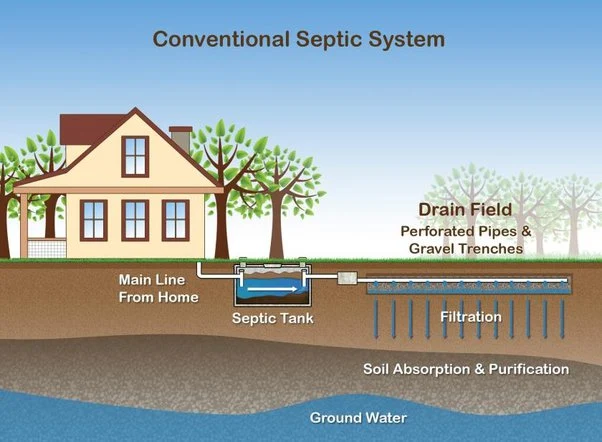A septic tank is a crucial component of a home’s wastewater treatment system, responsible for safely processing and disposing of sewage and wastewater. When a septic tank becomes too full, it can have various unpleasant and potentially hazardous consequences. This article will explore the risks associated with a full septic tank, the signs indicating a problem, and the solutions to address and prevent issues.
Understanding a Full Septic Tank:

A septic tank becomes too full when the accumulation of solid waste, sludge, and scum exceeds the tank’s capacity. This can occur due to several factors, including infrequent pumping, excessive water usage, or introduction of non-biodegradable materials into the system. When a septic tank is too full, it can impede the flow of wastewater, cause backups, and lead to environmental contamination.
Consequences of a Full Septic Tank:
- Backups and Slow Drains: One of the most noticeable signs of a full septic tank is backups and slow drains throughout the home. Wastewater may go back into sinks, showers, and toilets, causing foul odours, gurgling noises, and difficulty flushing.
- Odours and Surface Ponding: A full septic tank can emit foul odours inside and outside the home, indicating the presence of sewage and wastewater. Surface ponding, or water pooling on the ground above the septic tank or drain field, may also occur, indicating a problem with the system’s drainage.
- Health Risks: Exposure to raw sewage and wastewater poses significant health risks, including bacterial and viral infections. Contact with contaminated water can lead to gastrointestinal illnesses, skin infections, and respiratory problems, particularly for individuals with compromised immune systems.
- Property Damage: A full septic tank can cause structural damage to the property, including foundation instability, soil erosion, and damage to landscaping and hardscaping features. Surface ponding and saturated soil can compromise the stability of structures and pose safety hazards.
- Environmental Contamination: When untreated sewage and wastewater are released, they contaminate soil, groundwater, and surface water sources. Nutrient-rich effluent can promote algal blooms, impair water quality, and harm aquatic ecosystems, posing risks to human health and wildlife.
Signs of a Full Septic Tank:
- Backups and Slow Drains: If sinks, showers, toilets, or other plumbing fixtures in the home are experiencing backups or slow drains, it may indicate a full septic tank.
- Foul Odors: Foul odours emanating from drains, toilets, or the area around the septic tank or drain field may indicate the presence of sewage and wastewater.
- Surface Ponding: Surface ponding, or standing water on the ground above the septic tank or drain field, may indicate a problem with the drainage system and an overloaded septic tank.
- Lush Vegetation: Unusually lush or green vegetation above the septic tank or drain field may indicate excessive nutrient levels in the soil, resulting from untreated effluent leaking from the system.
- Gurgling Noises: Gurgling or bubbling noises from drains or toilets when water drains may indicate air trapped in the plumbing system due to a full septic tank.
Solutions for a Full Septic Tank:
- Septic Tank Pumping: Schedule professional septic tank pumping to remove accumulated solid waste, sludge, and scum from the tank. Septic tank pumping should be performed by a licensed septic professional every 3-5 years, depending on household size and usage.
- Septic Tank Inspection: Conduct a thorough inspection of the septic tank and drainage system to identify any damage, leaks, or blockages contributing to the problem. A qualified septic professional can assess the tank’s condition and recommend appropriate repairs or maintenance.
- Reduce Water Usage: Minimize water usage in the home to alleviate strain on the septic system and prevent further overload. Implement water-saving measures such as fixing leaky faucets, using water-efficient fixtures, and spacing out laundry and dishwashing loads.
- Avoid Flushing Non-Biodegradable Items: Avoid flushing non-biodegradable items such as paper towels, sanitary products, wipes, and household chemicals down the toilet or drain. These items can clog pipes and overwhelm the septic system, leading to backups and damage.
- Implement Grease Traps: Install grease traps in kitchen sinks to capture grease, oil, and food scraps before they enter the septic system. Grease and solid waste can accumulate in the septic tank, leading to clogs and reduced efficiency.
Preventing Future Issues:
- Regular Maintenance: Schedule routine septic tank pumping and inspections by a qualified septic professional to ensure the system functions properly and address any potential issues before they escalate.
- Water Conservation: Practice water conservation to reduce the strain on the septic system and minimise the risk of overloading. Fix leaky faucets, use water-efficient appliances, and avoid excessive water usage.
- Proper Waste Disposal: Dispose of household waste properly by avoiding flushing non-biodegradable items down the toilet or drains. Use biodegradable and septic-safe cleaning products to minimise the impact on the septic system.
- Landscaping Considerations: Be mindful of landscaping and gardening activities near the septic tank and drain field. Avoid planting trees or shrubs with extensive root systems that can damage the septic system’s components.
- Education and Awareness: Educate household members about proper septic system care and maintenance. Encourage responsible water usage and waste disposal practices to minimise the risk of future septic tank issues.




